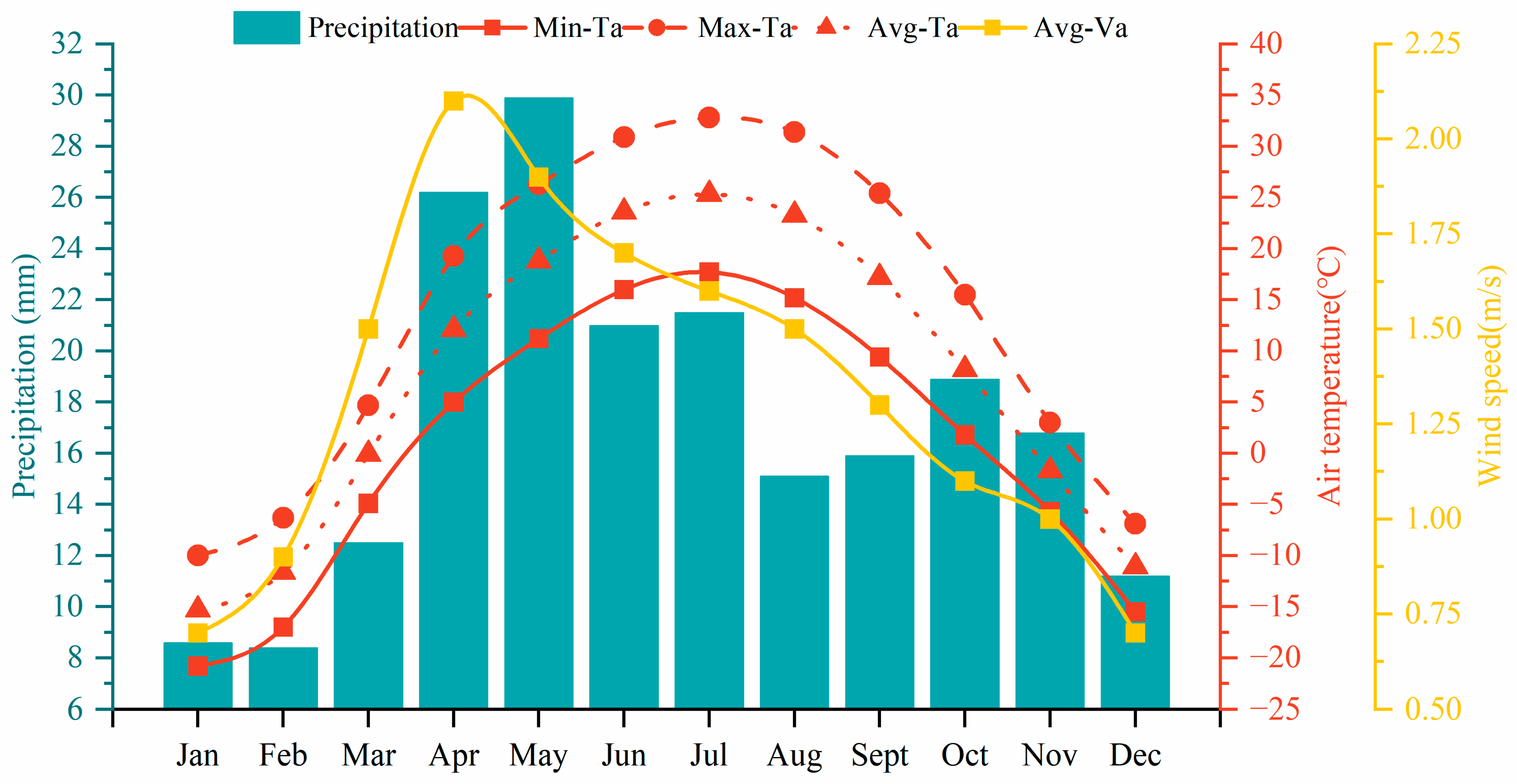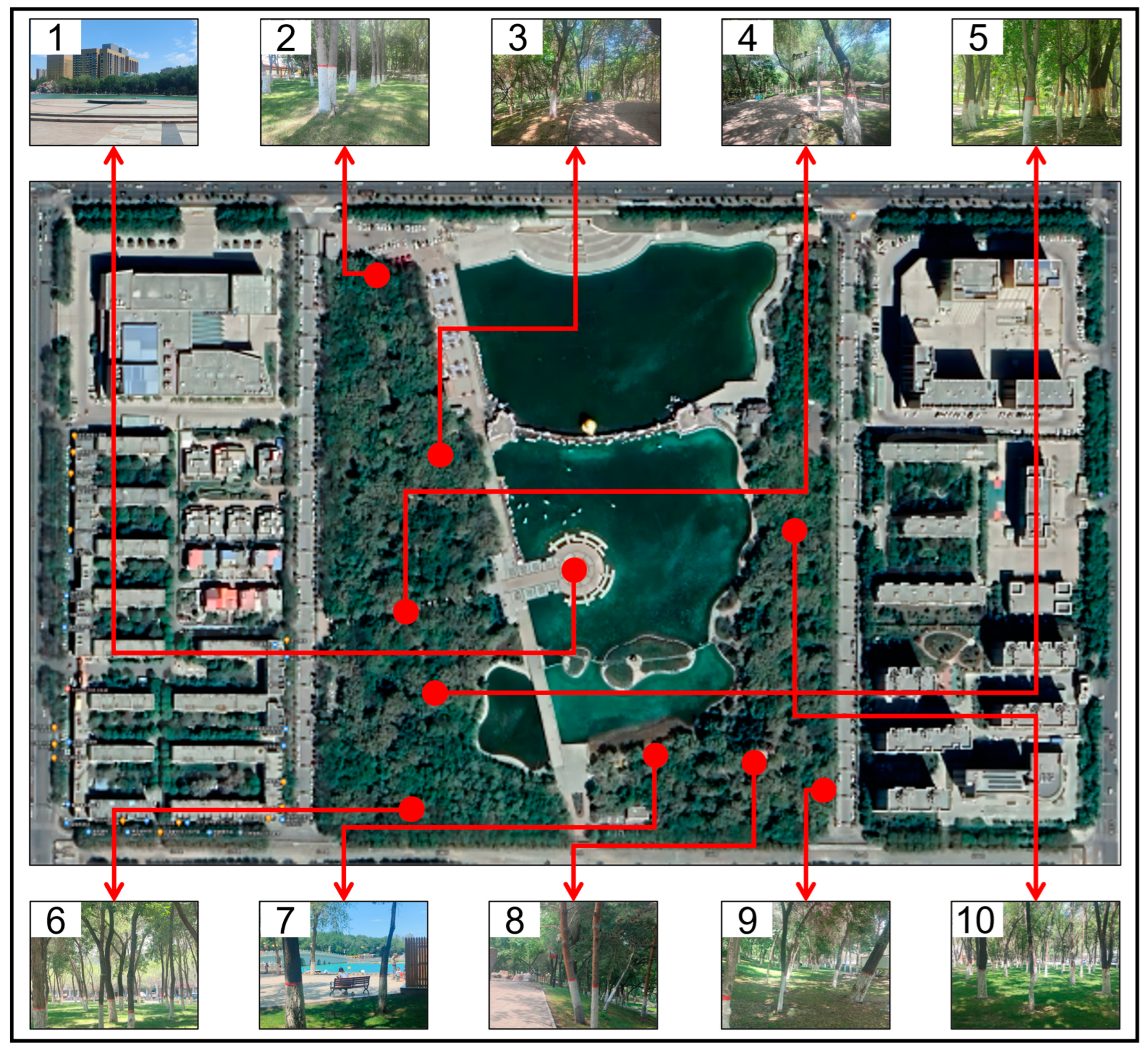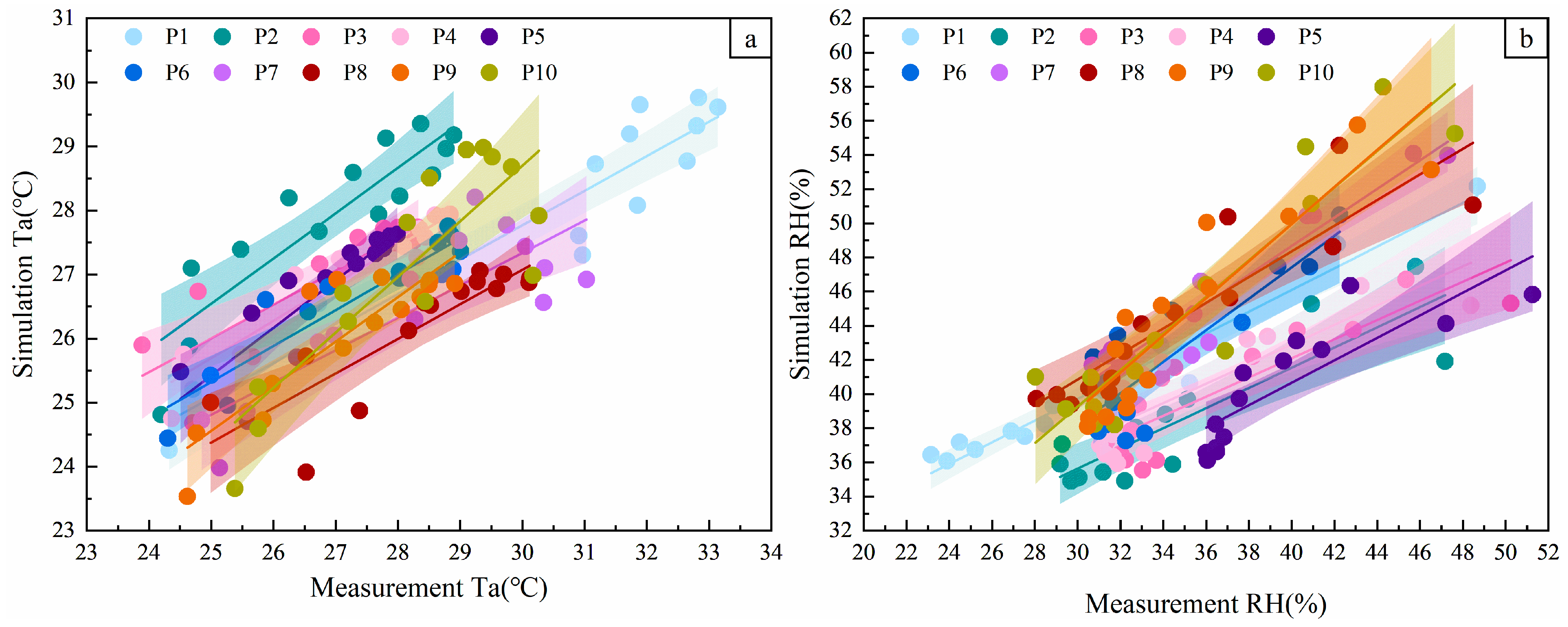Study on Summer Microclimate Analysis and Optimization Strategies for Urban Parks in Xinjiang—A Case Study of Mingzhu Park
Abstract
:1. Introduction
2. Materials and Methods
2.1. Study Area
2.2. Research Methods
2.2.1. Points Selection and Field Measurements
2.2.2. ENVI-Met Simulation
2.2.3. Validation of the Simulation
2.2.4. Thermal Comfort Assessment
3. Results and Discussion
3.1. Microclimate and Thermal Comfort Analysis
3.1.1. Analysis of Measured Results
3.1.2. Simulation Results and Analysis of Thermal Comfort Performance
3.2. Landscape Factors and Microclimate Correlation Analysis
3.2.1. Landscape Characterization and Microclimate Correlation
3.2.2. Correlation Analysis among Microclimate Factors
3.2.3. Correlation Analysis between Microclimate Factors and Thermal Comfort
3.3. Optimizing Design Strategies
3.3.1. Optimization Program
- Water Body Optimization Design
- 2.
- Greenery Optimization Design
3.3.2. Optimized Design Verification
3.4. Limitations and Future Works
4. Conclusions
- (1)
- Different landscape features significantly impact microclimatic factors and thermal comfort. Vegetation provides shading and transpiration, thereby cooling and humidifying the environment. During the day, water surface temperatures exceed those of shaded areas, while at night, water bodies enhance humidity. Slopes contribute to cooling and wind reduction. Granite and red bricks have low specific heat capacities, causing rapid temperature increases and subsequent cooling when not exposed to sunlight. Trees and slopes greatly improve thermal comfort (PET), with the primary influences being solar radiation during the day and temperature at night. Areas with trees and water in the park offer better thermal comfort.
- (2)
- The correlation between landscape features and microclimate shows that vegetation significantly affects cooling, increasing humidity, reducing wind speed, blocking solar radiation, and lowering the PET. When fully exposed to sunlight without shade, water bodies absorb significant solar radiation, leading to higher temperatures. Although evaporation can lower the surrounding temperatures, the air above the water remains warmer than in shaded areas, raising temperatures in those spaces.
- (3)
- There are significant correlations among air temperature, relative humidity, wind speed, and mean radiant temperature. Air temperature is negatively correlated with relative humidity and positively correlated with wind speed and mean radiant temperature. Relative humidity is negatively correlated with wind speed and mean radiant temperature, while wind speed is positively correlated with mean radiant temperature.
- (4)
- Microclimatic factors show significant correlations with the PET. Air temperature, wind speed, and mean radiant temperature are positively correlated with thermal comfort, while relative humidity is negatively correlated. The correlation ranking is as follows: mean radiant temperature > air temperature > humidity > wind speed, indicating that solar radiation greatly affects the comfort levels in Xinjiang.
- (5)
- After optimizing the park by increasing the number of trees and designing dispersed water bodies, the average air temperature at 2:00 p.m. decreased by 0.35 °C, the average relative humidity increased by 0.88%, and the average PET decreased by 1.35 °C. The proportion of PET > 41 °C decreased the most at 11:00 AM from 17.23% to 7.61%, a reduction of 9.62%. The park’s average PET decreased by 1.86 °C, the PET in the western built-up area by 0.13 °C, and the PET in the eastern built-up area by 0.35 °C, with an overall reduction of 0.67 °C in the study area. The park’s thermal comfort improved, while the enhancement in thermal comfort for the built-up areas on the east and west sides was minimal.
Author Contributions
Funding
Institutional Review Board Statement
Informed Consent Statement
Data Availability Statement
Conflicts of Interest
References
- Klein, T.; Anderegg, W.R.L. A Vast Increase in Heat Exposure in the 21st Century Is Driven by Global Warming and Urban Population Growth. Sustain. Cities Soc. 2021, 73, 103098. [Google Scholar] [CrossRef]
- Jumadi; Sari, D.N.; Fikriyah, V.N.; Pratama, B.A.; Wardah, H.; Madani, D.T.; Priyono, K.D.; Hadibasyir, H.Z.; Danardono; Saputra, A. Influence of Urban Growth on Urban Heat Island Phenomenon around Jakarta, Indonesia: Insight from Depok and South Tangerang City. IOP Conf. Ser. Earth Environ. Sci. 2024, 1291, 012001. [Google Scholar] [CrossRef]
- Du, H.; Zhan, W.; Voogt, J.; Bechtel, B.; Chakraborty, T.C.; Liu, Z.; Hu, L.; Wang, Z.; Li, J.; Fu, P.; et al. Contrasting Trends and Drivers of Global Surface and Canopy Urban Heat Islands. Geophys. Res. Lett. 2023, 50, e2023GL104661. [Google Scholar] [CrossRef]
- Zheng, S.; Chen, X.; Liu, Y. Impact of Urban Renewal on Urban Heat Island: Study of Renewal Processes and Thermal Effects. Sustain. Cities Soc. 2023, 99, 104995. [Google Scholar] [CrossRef]
- Yadav, N.; Rajendra, K.; Awasthi, A.; Singh, C.; Bhushan, B. Systematic Exploration of Heat Wave Impact on Mortality and Urban Heat Island: A Review from 2000 to 2022. Urban Clim. 2023, 51, 101622. [Google Scholar] [CrossRef]
- Yi, C.; Peng, C.; Robinson, D. Modelling Urban Dwellers’ Indoor Heat Stress to Enhance Heat-Health Warning and Planning. Build. Environ. 2023, 243, 110623. [Google Scholar] [CrossRef]
- Feng, F.; Ma, Y.; Li, H.; Zhang, Y.; Cheng, B.; Wang, H.; Shen, J. Effects of Temperature on Incidence of Bacillary Dysentery in a Temperate Continental Arid Climate City in Northwest China. Environ. Geochem. Health 2023, 45, 4043–4056. [Google Scholar] [CrossRef]
- Li, D.; Wang, L.; Liao, W.; Sun, T.; Katul, G.; Bou-Zeid, E.; Maronga, B. Persistent Urban Heat. Sci. Adv. 2024, 10, eadj7398. [Google Scholar] [CrossRef]
- Lasky, E.; Costello, S.; Ndovu, A.; Aguilera, R.; Weiser, S.D.; Benmarhnia, T. The Health Benefits of Reducing Micro-Heat Islands: A 22-Year Analysis of the Impact of Urban Temperature Reduction on Heat-Related Illnesses in California’s Major Cities. Sci. Total Environ. 2024, 949, 175284. [Google Scholar] [CrossRef]
- Kim, Y.; Shin, Y.; Cho, H. Influencing Factors on Thermal Comfort and Biosignals of Occupant—A Review. J. Mech. Sci. Technol. 2021, 35, 4201–4224. [Google Scholar] [CrossRef]
- Chan, S.Y.; Chau, C.K. On the Study of the Effects of Microclimate and Park and Surrounding Building Configuration on Thermal Comfort in Urban Parks. Sustain. Cities Soc. 2021, 64, 102512. [Google Scholar] [CrossRef]
- Luo, X.; Zhao, Y.; Li, Y.; Yang, J.; Guo, T. Effects of Tree Species and Planting Forms on the Thermal Comfort of Campsites in Hot and Humid Areas of China. Int. J. Biometeorol. 2024, 68, 1437–1449. [Google Scholar] [CrossRef]
- Liu, H.; Lim, J.Y.; Wint Hnin Thet, B.; Lai, P.-Y.; Koh, W.S. Evaluating the Impact of Tree Morphologies and Planting Densities on Outdoor Thermal Comfort in Tropical Residential Precincts in Singapore. Build. Environ. 2022, 221, 109268. [Google Scholar] [CrossRef]
- Keikhosravi, G.; Khalidi, S.; Shahmoradi, M. Effects of Climates and Physical Variables of Parks on the Radius and Intensity of Cooling of the Surrounding Settlements. Urban Clim. 2023, 51, 101601. [Google Scholar] [CrossRef]
- Xu, H.; Lin, X.; Lin, Y.; Zheng, G.; Dong, J.; Wang, M. Study on the Microclimate Effect of Water Body Layout Factors on Campus Squares. Int. J. Environ. Res. Public Health 2022, 19, 14846. [Google Scholar] [CrossRef] [PubMed]
- Cureau, R.J.; Pigliautile, I.; Pisello, A.L. Seasonal and Diurnal Variability of a Water Body’s Effects on the Urban Microclimate in a Coastal City in Italy. Urban Clim. 2023, 49, 101437. [Google Scholar] [CrossRef]
- Yang, B.; Olofsson, T.; Nair, G.; Kabanshi, A. Outdoor Thermal Comfort under Subarctic Climate of North Sweden—A Pilot Study in Umea. Sust. Cities Soc. 2017, 28, 387–397. [Google Scholar] [CrossRef]
- Wu, Z.; Man, W.; Ren, Y. Influence of Tree Coverage and Micro-Topography on the Thermal Environment within and beyond a Green Space. Agric. For. Meteorol. 2022, 316, 108846. [Google Scholar] [CrossRef]
- Yang, W.; Lin, Y.; Li, C.-Q. Effects of Landscape Design on Urban Microclimate and Thermal Comfort in Tropical Climate. Adv. Meteorol. 2018, 2018, 2809649. [Google Scholar] [CrossRef]
- Haeri, T.; Hassan, N.; Ghaffarianhoseini, A. Evaluation of Microclimate Mitigation Strategies in a Heterogenous Street Canyon in Kuala Lumpur from Outdoor Thermal Comfort Perspective Using Envi-Met. Urban Clim. 2023, 52, 101719. [Google Scholar] [CrossRef]
- Elnabawi, M.H.; Jamei, E. The Thermal Perception of Outdoor Urban Spaces in a Hot Arid Climate: A Structural Equation Modelling (SEM) Approach. Urban Clim. 2024, 55, 101969. [Google Scholar] [CrossRef]
- Nasrollahi, N.; Namazi, Y.; Taleghani, M. The Effect of Urban Shading and Canyon Geometry on Outdoor Thermal Comfort in Hot Climates: A Case Study of Ahvaz, Iran. Sustain. Cities Soc. 2021, 65, 102638. [Google Scholar] [CrossRef]
- Banerjee, S.; Pek, R.X.Y.; Yik, S.K.; Ching, G.N.; Ho, X.T.; Dzyuban, Y.; Crank, P.J.; Acero, J.A.; Chow, W.T.L. Assessing Impact of Urban Densification on Outdoor Microclimate and Thermal Comfort Using ENVI-Met Simulations for Combined Spatial-Climatic Design (CSCD) Approach. Sustain. Cities Soc. 2024, 105, 105302. [Google Scholar] [CrossRef]
- Feng, L.; Shuai, L.; Zhou, Y.; Zhang, X.; Sun, J. Improving the Green Space Arrangement in Residential Areas from the Perspective of Tree Leaf Temperature Utilizing Scenario Simulation in ENVI-Met. Sci. Total Environ. 2024, 918, 170650. [Google Scholar] [CrossRef]
- Tsoka, S.; Tsikaloudaki, A.; Theodosiou, T. Analyzing the ENVI-Met Microclimate Model’s Performance and Assessing Cool Materials and Urban Vegetation Applications—A Review. Sustain. Cities Soc. 2018, 43, 55–76. [Google Scholar] [CrossRef]
- Migliari, M.; Babut, R.; De Gaulmyn, C.; Chesne, L.; Baverel, O. The Metamatrix of Thermal Comfort: A Compendious Graphical Methodology for Appropriate Selection of Outdoor Thermal Comfort Indices and Thermo-Physiological Models for Human-Biometeorology Research and Urban Planning. Sustain. Cities Soc. 2022, 81, 103852. [Google Scholar] [CrossRef]
- Gagge, A.P.; Fobelets, A.P.; Berglund, L.G. A Standard Predictive Index of Human Response to the Thermal Environment. Ashrae Trans 1986, 92, 709–731. [Google Scholar]
- Fanger, P.O. Thermal Comfort: Analysis and Applications in Environmental Engineering; Danish Technical Press: København, Denmark, 1972. [Google Scholar]
- Jendritzky, G.; de Dear, R.; Havenith, G. UTCI-Why Another Thermal Index? Int. J. Biometeorol. J. Int. Soc. Biometeorol. 2012, 56, 421–428. [Google Scholar] [CrossRef]
- Höppe, P. The Physiological Equivalent Temperature—A Universal Index for the Biometeorological Assessment of the Thermal Environment. Int. J. Biometeorol. 1999, 43, 71–75. [Google Scholar] [CrossRef]
- Cui, P.; Jiang, J.; Zhang, J.; Wang, L. Effect of Street Design on UHI and Energy Consumption Based on Vegetation and Street Aspect Ratio: Taking Harbin as an Example. Sustain. Cities Soc. 2023, 92, 104484. [Google Scholar] [CrossRef]
- He, X.; Shao, L.; Tang, Y.; Wu, S. Improving Children’s Outdoor Thermal Comfort: A Field Study in China’s Severely Cold Regions. Urban Clim. 2023, 51, 101620. [Google Scholar] [CrossRef]
- ISO 7726:1998; Ergonomics of the Thermal Environment—Instruments for Measuring Physical Quantities. ISO: Geneva, Switzerland, 2001.
- Ampatzidis, P.; Kershaw, T. A Review of the Impact of Blue Space on the Urban Microclimate. Sci. Total Environ. 2020, 730, 139068. [Google Scholar] [CrossRef] [PubMed]
- Pan, Z.; Xie, Z.; Wu, L.; Pan, Y.; Ding, N.; Liang, Q.; Qin, F. Simulation of Cooling Island Effect in Blue-Green Space Based on Multi-Scale Coupling Model. Remote Sens. 2023, 15, 2093. [Google Scholar] [CrossRef]
- Cao, B.; Chen, Q.; Du, M.; Cheng, Q.; Li, Y.; Liu, R. Simulation Analysis of the Cooling Effect of Urban Water Bodies on the Local Thermal Environment. Water 2022, 14, 3091. [Google Scholar] [CrossRef]
- Miao, J.; Tian, M.; Qu, L.; Zhang, X. Flexible, Transparent and Conductive Wearable Electronic Skin Based on 2D Titanium Carbide (MXene) Ink. Carbon 2024, 222, 118950. [Google Scholar] [CrossRef]
- Hou, Z.; Liu, X.; Tian, M.; Zhang, X.; Qu, L.; Fan, T.; Miao, J. Smart Fibers and Textiles for Emerging Clothe-Based Wearable Electronics: Materials, Fabrications and Applications. J. Mater. Chem. A 2023, 11, 17336–17372. [Google Scholar] [CrossRef]
- Zuo, X.; Fan, T.; Qu, L.; Zhang, X.; Miao, J. Smart Multi-Responsive Aramid Aerogel Fiber Enabled Self-Powered Fabrics. Nano Energy 2022, 101, 107559. [Google Scholar] [CrossRef]
- Fan, Q.; Miao, J.; Liu, X.; Zuo, X.; Zhang, W.; Tian, M.; Zhu, S.; Qu, L.; Zhang, X. Biomimetic Hierarchically Silver Nanowire Interwoven MXene Mesh for Flexible Transparent Electrodes and Invisible Camouflage Electronics. Nano Lett. 2022, 22, 740–750. [Google Scholar] [CrossRef]
- Chen, X.; He, Y.; Tian, M.; Qu, L.; Fan, T.; Miao, J. Core–Sheath Heterogeneous Interlocked Conductive Fiber Enables Smart Textile for Personalized Healthcare and Thermal Management. Small 2024, 20, 2308404. [Google Scholar] [CrossRef] [PubMed]
- Zuo, X.; Zhang, X.; Qu, L.; Miao, J. Smart Fibers and Textiles for Personal Thermal Management in Emerging Wearable Applications. Adv. Mater. Technol. 2023, 8, 2201137. [Google Scholar] [CrossRef]










| Measurement Point | Landscape Features | Distance to Water Body (m) | Altitude (m) | Gradient |
|---|---|---|---|---|
| P1 | The area provides spacious and clear views with a granite base and water on three sides. | 20 | 0 | Windward Slope |
| P2 | Located under tree shade on grass, it is near granite flooring on the north, a red brick walkway to the west, and surrounded by trees and grass on the east and south sides. | 50 | 0 | Windward Slope |
| P3 | Under trees with grass, it is next to a red brick path on the east and encircled by greenery to the west, north, and south. | 29 | 6 | Windward Slope |
| P4 | Located under tree cover with green ground, it is next to granite on the north and a red brick path on the west, with dense vegetation surrounding the south and east sides. | 76 | 2 | Windward Slope |
| P5 | Situated beneath a canopy of trees, with a verdant ground cover and encompassed by an expanse of trees and grassland. | 32 | 6 | Windward Slope |
| P6 | Situated beneath a canopy of trees, with a verdant ground cover and encompassed by an expanse of trees and grassland. | 80 | 0 | Leeward Slope |
| P7 | Located near water to the north, this spot features lush grass and is circled by granite paving, all under the shade of trees. | 20 | 0 | Windward Slope |
| P8 | Located under tree cover with lush grass. The south side has red brick paving, while the north side blends forest and grassy areas. | 72 | 9 | Windward Slope |
| P9 | The site is under tree cover with green ground and red brick pavement on the east, surrounded by dense vegetation and grass on the other three sides. | 104 | 0 | Leeward Slope |
| P10 | Located under tree cover with green ground, surrounded by a wide area of trees and grass. | 32 | 0 | Windward Slope |
| Measuring Instruments | Measurement Parameters | Range of Measurement | Accuracy | Instrument Photo |
|---|---|---|---|---|
| SMART METER wireless data acquisition device | Ta (°C) | −20~60 °C | ±0.3 °C |  |
| RH (%) | 0~95% | ±3% | ||
| Air Velocity Meter TM-403 | Va (m/s) | 0~25 m/s | 0.1 m/s |  |
| JTR04 black globe thermometer | Tg (°C) | 0~80 °C | ±1 °C |  |
| The ENVI-Met Model | |
|---|---|
| Modelling established |  |
| Simulations input | Shihezi (86°2′ E, 44°18′ N) |
| Simulation date | 12 July 2023 |
| Simulation time | 0:00 a.m.–24:00 p.m. |
| Wind speed at 10 m | 2.5 m/s |
| Wind direction | 315° |
| Roughness length | 0.1 |
| Initial air temperature range | Data from the National Meteorological Center |
| Initial relative humidity range | Data from the National Meteorological Center |
| Meteorological Elements | Norms | P1 | P2 | P3 | P4 | P5 | P6 | P7 | P8 | P9 | P10 |
|---|---|---|---|---|---|---|---|---|---|---|---|
| Air temperature | Pearson | 0.95 | 0.89 | 0.86 | 0.96 | 0.87 | 0.93 | 0.85 | 0.85 | 0.88 | 0.85 |
| R2 | 0.90 | 0.79 | 0.73 | 0.91 | 0.75 | 0.86 | 0.72 | 0.72 | 0.78 | 0.73 | |
| RMSE/°C | 2.77 | 1.22 | 0.84 | 0.75 | 0.52 | 1.06 | 2.15 | 2.35 | 1.26 | 1.39 | |
| Relative humidity | Pearson | 0.98 | 0.88 | 0.88 | 0.85 | 0.85 | 0.86 | 0.96 | 0.90 | 0.91 | 0.93 |
| R2 | 0.95 | 0.77 | 0.77 | 0.73 | 0.72 | 0.74 | 0.93 | 0.81 | 0.83 | 0.87 | |
| RMSE/% | 9.80 | 4.87 | 4.68 | 5.78 | 2.51 | 8.14 | 9.38 | 9.98 | 9.80 | 9.94 |
| Thermal Perception | Grade of Physical Stress | PET/°C |
|---|---|---|
| Very cold | Extreme cold stress | <4 |
| Cold | Strong cold stress | 4–8 |
| Cool | Moderate cold stress | 8–13 |
| Slightly cold | Slight cold stress | 13–18 |
| Comfortable | Neutral | 18–23 |
| Slightly warm | Slight heat stress | 23–29 |
| Warm | Moderate heat stress | 29–35 |
| Hot | Strong heat stress | 35–41 |
| Very hot | Extreme heat stress | >41 |
Disclaimer/Publisher’s Note: The statements, opinions and data contained in all publications are solely those of the individual author(s) and contributor(s) and not of MDPI and/or the editor(s). MDPI and/or the editor(s) disclaim responsibility for any injury to people or property resulting from any ideas, methods, instructions or products referred to in the content. |
© 2024 by the authors. Licensee MDPI, Basel, Switzerland. This article is an open access article distributed under the terms and conditions of the Creative Commons Attribution (CC BY) license (https://creativecommons.org/licenses/by/4.0/).
Share and Cite
Zhao, Z.; Li, J.; Fu, Z. Study on Summer Microclimate Analysis and Optimization Strategies for Urban Parks in Xinjiang—A Case Study of Mingzhu Park. Sustainability 2024, 16, 7687. https://doi.org/10.3390/su16177687
Zhao Z, Li J, Fu Z. Study on Summer Microclimate Analysis and Optimization Strategies for Urban Parks in Xinjiang—A Case Study of Mingzhu Park. Sustainability. 2024; 16(17):7687. https://doi.org/10.3390/su16177687
Chicago/Turabian StyleZhao, Zhao, Jie Li, and Zongchi Fu. 2024. "Study on Summer Microclimate Analysis and Optimization Strategies for Urban Parks in Xinjiang—A Case Study of Mingzhu Park" Sustainability 16, no. 17: 7687. https://doi.org/10.3390/su16177687








